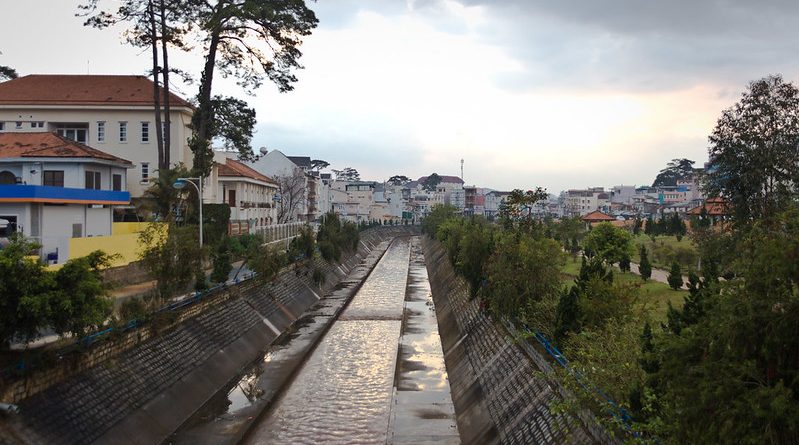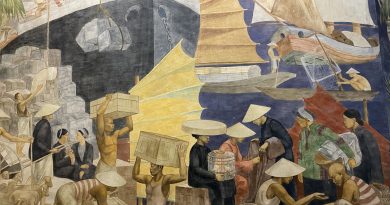Trekking from Dalat to the Central Highlands
Trek Essentials
Where: From Dalat, Northeast Vietnam
Best Season: Spring/Summer
Best Sights: Endangered hill tribes and the rare white elephant
Remember to bring: Jungle equipment
Watch out for: Unexploded US bombs
Where It’s At
Dalat is situated on a plateau in the central highlands at an altitude of almost 5000 ft and has a population of 130,000. To the north are the volcanic peaks of the Lang Biang Mountains rising to 2,400m. The town itself is in a beautiful setting by a lake and surrounded by rolling countryside which is probably why the French chose it as a hill station where hot and flustered expats could escape the stifling lowland heat of Saigon. Thanks to a tacit agreement between Hanoi and Saigon during the war the city was not bombed and remains much as it was half a century ago.
Our Journey Path (as featured in Treks in a Wild World)
The Treks crew leave the highlands of the North and catch a plane to Dalat, one of the most beautiful cities in Vietnam and a reminder of colonial grandness. From there it’s a trek through medicinal rainforests , then a bike ride along a section of the Ho Chi Minh trail, to join the elephant training Mnong tribe.
Lak Lake is surrounded by Mnong villages and early morning mists hang above the calm waters and mingle with the smoke from the longhouses. The lake can be explored by canoes which have been painstakingly hollowed out from tree trunks. One can stay overnight at Buon Juin – a Mnong village – where it is possible to watch the working elephants take their evening wallow in the lake. The Northern mountains of Vietnam represent the country at its most wild and inaccessible. It contains some of its most awe-inspiring scenery and a fascinating mosaic of hill tribes.
Did You Know?
– Over 30 Hill tribes inhabit the northeasth area. Some such as the Odu, Romam and Brau are in serious danger of becoming extinct. The area is also one of Vietnam’s most biologically important areas and new species are still being discovered in the rainforests. Medicinal plants flourish.
– Dalat is a city in the European sense with a cathedral, a university and a royal history.
– The countryside surrounding Dalat is extremely fertile and a large variety of fruit and vegetables flourish in the cool mountain air, many of which are grown by the minorities. If you visit themarket early morning it is a great opportunity to see them – especially subdivisions of the Khor – Tola, Baja, Lat, Nop and Ta Nhau. Many are extremely shy. The Khor sell custard apples whose leaves are crushed and then infused with hot water as a cure for malaria. Enormous carrots and marrows are for sale as well as fabulous flowers. You will also see people selling brown furry animal-like objects. These are cu ly and they are made from fern fibres which are used in traditional medicine to stop wounds bleeding.
– Dalat, the ‘city of love’ has always been a mecca for Vietnamese honeymooners.
– It wasn’t just the French who chose to chill out in Dalat. Vietnam’s last Emporer Bao Dai had a summer palace here that made a great base for hunting trips in the surrounding countryside.
– A favourite past time of the locals is chewing betelnut – a stimulant that colours teeth red, makes them fall out, but makes you feel very lightheaded!
Ho Chi Minh Trail
Route 27 out of Dalat follows the old Ho Chi Minh Trail – the Viet Cong‘s secret supply route linking the north and south. It was mostly a network of footpaths under the protective canopy of the jungle. The US bombed the living daylights out of the trail in a hopeless attempt to shut it down. The total tonnage of bombs dropped on the trail was greater than all the bombs dropped in WW2. They also dumped defoliants such as Agent Orange in an attempt to expose the trail.
· The last battle of the American war was fought in this area in March 1975.The road from Dalat to the above villages follows the old Ho Chi Minh trail and its easy to figure out why it was so tough for the Americans to spot the trail. Tucked high and deep in the Central highlands rugged and beautiful Truong Son Mountains, the road meanders with seemingly impassable switchbacks. It taxes the imagination to see how the Viet Cong were able to get anything down it, much less themselves.
There is a thriving industry in re-cycled war scrap metal in Vietnam, particularly along the trail. The metal is principally sold to Japan where it is turned into cars which are then shipped to….you guessed it…the United States.
Tribes
Montagnards Hill Tribes
The central highlands of Vietnam are home to a number of Hill Tribes that are descended fromMalayo-Polynesians and Khmer. These are the aboriginal Indochinese people. They are commonly known as montagnards – a term coined by the French meaning mountain people. The Vietnamese know them as Moi which means savage. They refer to themselves as ‘dega‘ which mean first people.
One of the most tragic and little known consequences of the Vietnam war was the decimation and destruction it brought to the montagnards of the central highlands. By the war’s end 85% of their villages were either in ruins or abandoned. Over 200,000 mountain people died. The montagnards were recruited and trained by the CIA and US army to fight against the Viet Cong. This loyalty to the US has not endeared them to the communist government in power since 1975 and there have been accusations of severe ‘cultural leveling’ in this area. The montagnards have not been given access to medicine and have had their lands taken away from them. The Government has banned the teaching of their languages and forced them to marry Vietnamese in order to dilute and destroy their cultural heritage. It is feared by some that within 20 years their unique culture will have been totally wiped out.
The Mnong Tribe
The Shamanistic-Anamanistic Mnong tribe have been famed elephant catchers for hundreds of years and although elephant populations are declining they still use them for their traditional role of dragging logs in the forest. The Mnong culture is closely linked to elephants. For instance they believe that drinking elephant urine has medicinal properties and so not a drop is wasted!
The Mnong live in houses built on stilts and like to drink alcohol from communal jars using pipes. Matriarchy is observed and the children take the family name of the mother. They believe in the existence of many spirits which are related to their life. One such spirit is mother rice which holds a special role. The Mnong file their teeth before marriage.
Nature
Yok Don National Park is home to the rarely seen Asian Tiger, leopards, wild elephants andbuffalo. It is also home to the rare white elephant.
70 miles north of Lak Lake is another option for elephant antics – Ban Don village which lies in close proximity to Yok Don National Park. This village has a long tradition of taming the forest’s elephants and you can visit the tomb of Khun Ju-Nop, known as the king elephant catcher who died in 1924. Each man in the village has a nickname according to the number of elephants he has caught. In Darlac there are 500 elephants which have been domesticated and are used to hunt wild ones. Visitors to the village will often be invited to drink from a communal jar and following copious rice wine there is likely to be an impromptu musical performance using gongs. The Mnong live in stilt long houses – inside many things hang from the walls to dry – food such as frog, lizard and snake. After a birth in the family the placenta will be hung up to dry which is considered a powerful remedy for rheumatic problems.
Elephant facts
– The tip of an elephant’s trunk is 10 times as sensitive as your fingertips. The trunk has over 100,000 muscles in it – the human body has just 639 in total. Elephants produce enough methane gas every day to fuel a car for 20 hours. In its lifetime the average elephant walks the equivalent of 14 times around the planet. At night elephants cover them selves in mud to protect them from insects (and wash it off in morning).
– The Mnong tribe are famous for catching and taming wild elephants which are then used as beasts of burden. All Mnong have a nickname according to how many elephants he has caught.
·
– The night before a hunt the Mnong cannot have sex
– The Mnong perform a ritual with the special rope used to catch the elephant.
– Fewer than 100 elephants are remaining in the wild. Once trained, an elephant lives up to 40 years with its trainer.
More Information
Buffalo Tours Vietnam
The treks crew did their journey with the help of Buffalo Tours. This is an expert tour operator with great, friendly tour guides.
Buffalo Tours Vietnam
Marketing
8 Ngo Hang Bun,
Hanoi
Tel: 00 844 71 62 079
Fax: 00 844 716 4729
Vietnam Adventures
Ultimate adventure travel guide specialists for Vietnam




